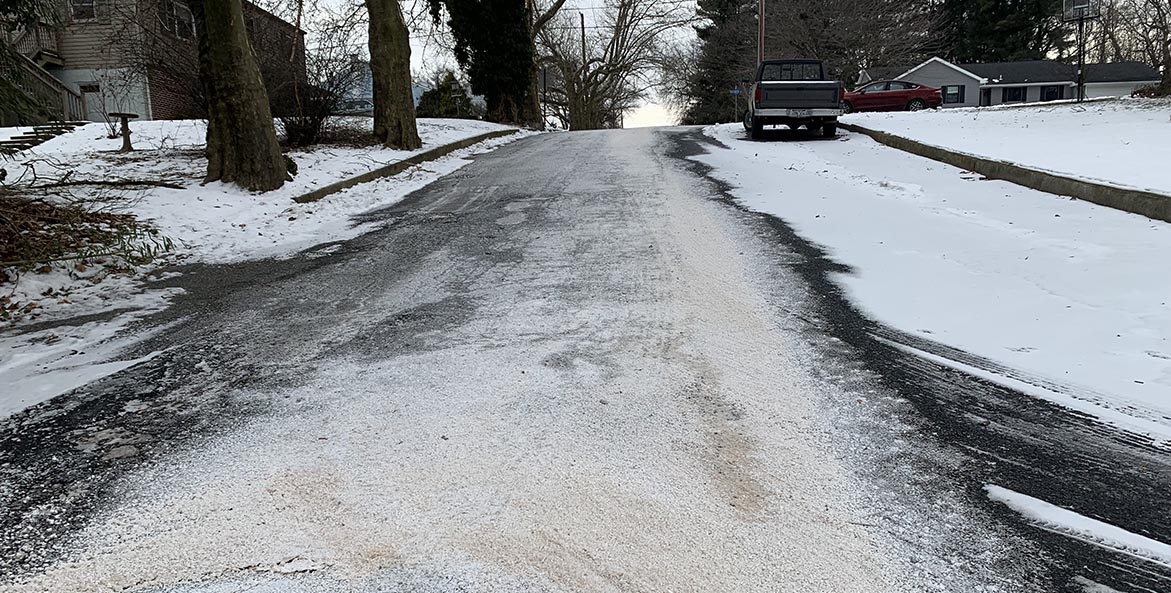Some of us are old enough to remember the salt company slogan of the 1900s, “When it rains, it pours!”
A more contemporary meaning of that phrase is that when something bad occurs, it usually happens more than once within a short period of time.
When rain poured on Pennsylvania recently, much of the deicing agents used on our local and state roads hitched a ride with the resulting runoff to the nearest waterbody. Road deicers are most often some forms of salt. This creates an unsavory, salty situation in our streams.
Snow can be a good thing and many parts of the Commonwealth have gotten some this winter. Normally, when snow slowly melts with the gradual warming in spring, it can seep into the ground. There it becomes a primary source of clean, cold water feeding into our streams during the dry summer months. It helps keep iconic critters like our native brook trout and the Eastern hellbender, happy and healthy.
Historically, Pennsylvania is such a snow-heavy state that it is referred to as the Salt Belt, named for its use of salt on roadways to control snow and ice.
The state Department of Transportation (PennDOT) has budgeted over $197 million for clearing roads of snow and ice this winter. In the winter of 2022-23 they applied nearly 447,000 tons of salt and roughly 310,000 tons of anti-skid materials to state roads. Thousands more tons were likely added by local municipal road crews.
Last winter, PennDOT also pretreated roads with more than 9.1 million gallons of salt brine. The water in the brine evaporates and the remaining salt helps prevent ice from forming a strong bond with the road surface. When salt that has accumulated on road surfaces is swept away by rain, it can make for a bad brew.
Road salt, or halite, is an unpurified version of good old table salt, sodium chloride. But sometimes additives help trucks spread it onto roadways without caking.
The salt melts snow and ice by lowering the freezing point below 32 degrees Fahrenheit. When these compounds do their job, they dissolve in the melted snow and ice where they either accumulate in nearby soils or with rain or thaw find their way to the nearest waterbody.
Although the road salt seemingly disappears, it just dissolves. In doing so, the mineral chlorides separate into individual elements. These elements, particularly chloride, are toxic to the myriad of critters in our rivers and streams who need freshwater, not salty water, to survive and thrive. Scientists call this “freshwater salinization syndrome.” It’s a fancy term for what happens when streams turn salty.
A study published in the Proceedings of the National Academy of Sciences suggests that salt ions are changing the chemistry of freshwater streams across the nation, including in Pennsylvania. Researchers analyzed five decades of data from 232 U.S. Geological Survey (USGS) river and stream monitoring sites. They found that salt ions increased by 37 percent.
Villanova University reported that over the course of 20 years six urban and suburban streams in southeastern Pennsylvania showed signs of this syndrome. The Susquehanna River Basin Commission has been studying this issue at 12 sites throughout the basin. Their findings to date show a similar pattern. At some study sites, chloride concentrations even briefly exceeded the Pennsylvania state safe drinking water standard after runoff events.
Salty streams can also cause big problems by corroding bridges and pipes, polluting drinking water supplies, and leaching heavy metals and nutrients.
But the impacts are not limited to water. Salty soils can kill plants as evidenced by dead or diseased vegetation found along many roadways. When these plants die, their ability to provide food and habitat for wildlife is lost. It also gives non-native invasive plant species an opening.
Researchers are exploring a myriad of alternatives to road salts. Recently, scientists at Drexel University reported that they developed a type of concrete that can release heat to melt snow and ice. It works by enhancing the ability of the concrete to absorb heat energy from the sun and then slowly release heat when wintery weather arrives.
Around the home we can do our part by not using salt on driveways, walkways, and other slick surfaces.
Some store-bought salt products may include impurities that include trace metals that can also be toxic. Some salts may also contain an anti-caking device such as forms of cyanide, which is also toxic.
Sand is a popular go-to alternative to salt for improving traction on slick surfaces. But it too can find its way into streams where it can smother habitat important to fish and other aquatic life.
Proper application, both in the timing and amount applied, is key to preventing stressing, or even killing, sensitive plants and animals on the land and in our water.




